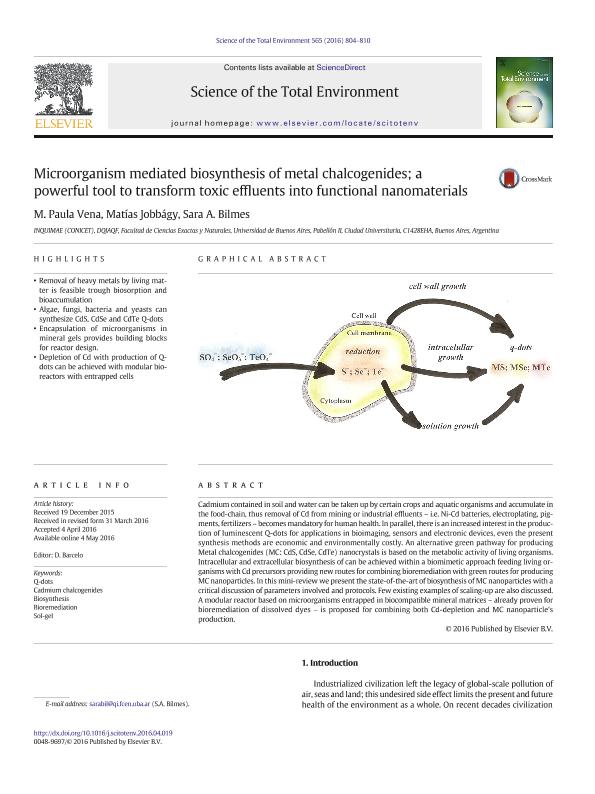Artículo
Microorganism mediated biosynthesis of metal chalcogenides; a powerful tool to transform toxic effluents into functional nanomaterials
Fecha de publicación:
12/2015
Editorial:
Elsevier Science
Revista:
Science of the Total Environment
ISSN:
0048-9697
Idioma:
Inglés
Tipo de recurso:
Artículo publicado
Clasificación temática:
Resumen
Cadmium contained in soil and water can be taken up by certain crops and aquatic organisms and accumulate in the food-chain, thus removal of Cd from mining or industrial effluents – i.e. Ni-Cd batteries, electroplating, pigments, fertilizers – becomes mandatory for human health. In parallel, there is an increased interest in the production of luminescent Q-dots for applications in bioimaging, sensors and electronic devices, even the present synthesis methods are economic and environmentally costly. An alternative green pathway for producing Metal chalcogenides (MC: CdS, CdSe, CdTe) nanocrystals is based on the metabolic activity of living organisms. Intracellular and extracellular biosynthesis of can be achieved within a biomimetic approach feeding living organisms with Cd precursors providing new routes for combining bioremediation with green routes for producing MC nanoparticles. In this mini-review we present the state-of-the-art of biosynthesis of MC nanoparticles with a critical discussion of parameters involved and protocols. Few existing examples of scaling-up are also discussed. A modular reactor based on microorganisms entrapped in biocompatible mineral matrices – already proven for bioremediation of dissolved dyes – is proposed for combining both Cd-depletion and MC nanoparticle's production.
Palabras clave:
Bioremediation
,
Biosynthesis
,
Cadmium Chalcogenides
,
Q-Dots
,
Sol-Gel
Archivos asociados
Licencia
Identificadores
Colecciones
Articulos(INQUIMAE)
Articulos de INST.D/QUIM FIS D/L MATERIALES MEDIOAMB Y ENERGIA
Articulos de INST.D/QUIM FIS D/L MATERIALES MEDIOAMB Y ENERGIA
Citación
Vena, María Paula; Jobbagy, Matias; Aldabe, Sara Alfonsina; Microorganism mediated biosynthesis of metal chalcogenides; a powerful tool to transform toxic effluents into functional nanomaterials; Elsevier Science; Science of the Total Environment; 565; 12-2015; 804-810
Compartir
Altmétricas




